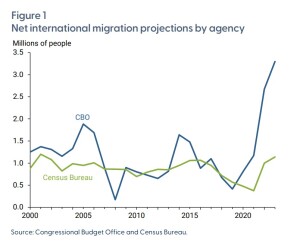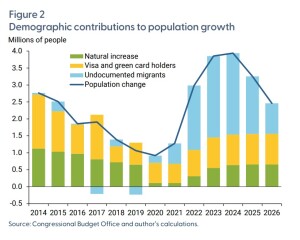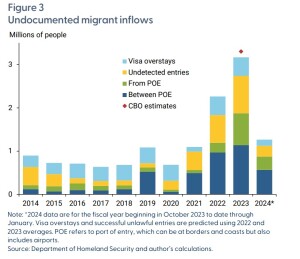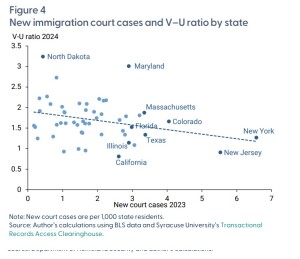For accurate predictions, models depend on accurate input data. For this reason, the U.S. Congressional Budget Office (CBO) routinely updates demographic information about the United States. Recently, errors on the orders of millions of people have come to light. Why are the estimates of the number of immigrants off base, and what are the effects on economic planning?
“The CBO now projects that 3.3 million people on net immigrated to the United States in both 2023 and 2024,” according to an economic letter released by the Federal Reserve Bank of San Francisco (FRBSF) on July 15, 2024. “These estimates are each about 2 million people higher than the past year’s estimates, mostly driven by higher estimates of undocumented immigrants.”
The Economic Letter, titled “Recent Spike in Immigration and Easing Labor Markets,” explores the current relationship between immigration and unemployment, and is authored by Evgeniya Duzhak, who is a regional policy economist in the Economic Research Department of the FRBSF.
“The CBO is the first agency to highlight the number of undercounted immigrants during the post-pandemic surge,” Duzhak writes. The CBO recently revised estimates for net international migration (NIM) to about three times larger than the Census estimates as shown in Figure 1.
Undercounting is due to the Covid-19 pandemic and the fact that “many of the uncounted U.S. migrants live in group-style quarters or buildings with multiple housing units.”
U.S. population growth hovers around one to two million a year due to natural increase and the green card / visa system. When Duzhak adds the estimate of undocumented NIM, the growth shows a spike as seen in Figure 2.
She uses data from the Department of Homeland Security (DHS) and identifies four groups, including persons in the official point-of-entry (POE) chain.
- Visa overstays
- Undetected entries
- From POE
- Between POE
“The first group includes migrants who arrive at official points of entry (POE, green bars), usually relying on immigration parole or demonstration of a credible fear and desire to apply for asylum to gain legal admission to the country. The share of migrants that arrived at POE in 2023 was much larger than in 2022 mostly due to the extension of the humanitarian parole that motivated more people to use legal pathways.”
The relative contributions from these groups are shown in Figure 3, along with the total CBO estimates.
The humanitarian parole applies to “people coming from countries in turmoil, including Cuba, Haiti, Ukraine, and Nicaragua,” the economic letter notes, as well as to certain Venezuelans.
How does this translate to the labor market?
It’s not an immediate effect. “People in those categories are immediately eligible for work permits, although processing those permits took a median of nine months in 2022.”
The labor market is not a single, homogeneous entity.
According to the Bank for International Settlements, the labor market is said to be “tight” when the imbalance between labor supply and labor demand manifests itself in an abundance of job opportunities along with a scarcity of workers available and willing to take those jobs.
To quantify the impact of the higher volume of migrants on labor market tightness, Duzhak examines the vacancy-to-unemployment or “V–U ratio.” The state-by-state data in Figure 4 are from the Bureau of Labor Statistics (BLS). She notes, “Some states attract more immigrants and therefore have a different response in the local V–U ratio.”
“The strong migration flow has eased regional labor market tightness,” she concludes. Good news is ahead. She writes, “further declines in the V–U ratio are likely in 2024.”♠️
Click here to read the Economic Letter this posting is based on.
The graphs in this posting are from the FRBSF report. Permission pending.
Other visuals are from pix4free.org and freepik.com.







